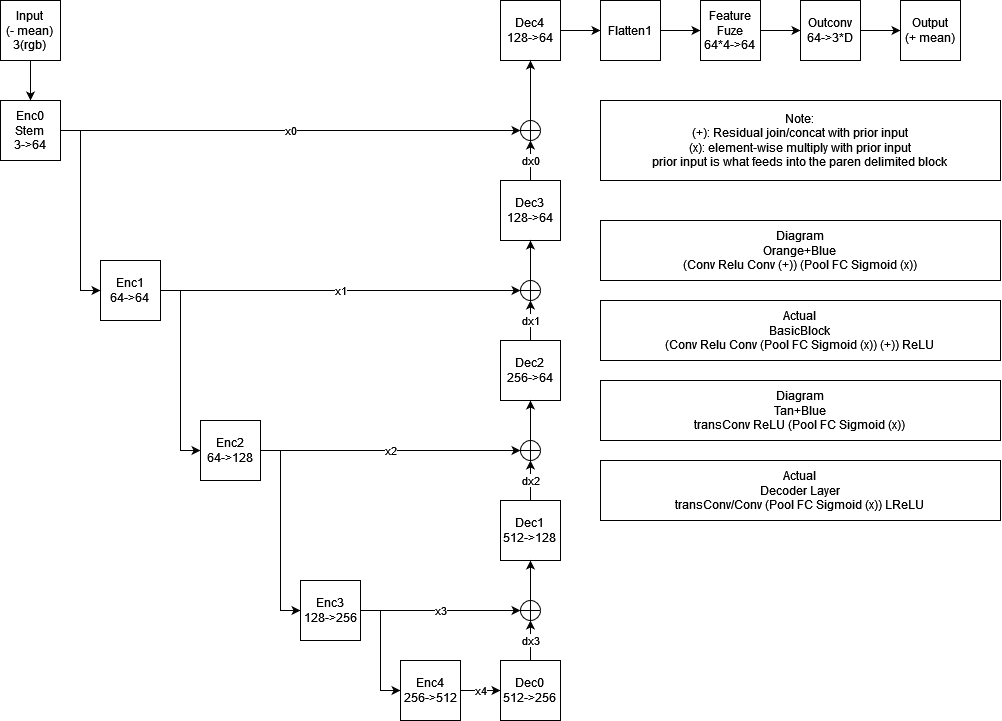Original (30 FPS)
2x Interpolated (30 FPS)
Original (30 FPS)
2x Interpolated (30 FPS)
Original (30 FPS)
2x Interpolated (30 FPS)
It is said that a picture is worth a thousand words.
Just think, at 24 fps, just one minute of sound-free video footage would be worth 1,440,000 words.
In a world of high refresh rate monitors and 4K60 videos, imagine a world where we instead stored lower frame rate videos and dynamically adjust them to the desired smoothness.
- Lower bandwith would be required for streaming video.
- More videos could be stored on the same hard drive.
- Animators would no longer need to draw in-between frames.
Such magic technology is no longer purely in the realm of science fiction.
Frame interpolation generates new frames that go in between existing video frames. Here, we attempt to implement one method of frame interpolation, a machine learning model called FLAVR.
We are attempting to implement the FLAVR architecture at a low level using CUDA kernels and cuDNN. Our work is based off the model presented by Tarun Kalluri, Deepak Pathak, Manmohan Chandraker, and Du Tran in their paper FLAVR: Flow-Agnostic Video Representations for Fast Frame Interpolation.
The GPU, or Graphics Processing Unit, was initially created to offload the task of displaying images from the CPU. This task often involved performing the same computation on a bunch of independent pixels. As they became more powerful, GPUs carved out a niche for accelerating massively parallel computation tasks.
Neural Networks, are widely used in Machine Learning. Between the many interconnected neurons and the weights/biases that associated with each one, neural networks consist of a giant pile of linear algebra, with some nonlinear math also thrown in for good measure (to be a universal classifier).
Just take the example of matrix multiplication, each element of the product is an independent dot product of factor matrices. Because of the abundance of parallel computation, GPUs are used to do machine learning tasks like training neural networks and running them to perform inference. CUDA (Compute Unified Device Architecture) is a parallel computing API made by NVIDIA for general purpose GPU computing.
Since one of the main jobs of a computer is to compute, there are many APIs that aim to speed up computation and/or provide a unified interface so other programs may use them. Oftentimes, they make use of the modern bells and whistles that CPUs have, for example, SIMD and Vector extensions to be as fast as possible. Famous ones include BLAS: Basic Linear Algebra Subprograms. NVIDIA has libraries that accelerate such tasks by running them on the GPU. cuBLAS is the GPU version of BLAS, and their cuDNN library implements many functions used in Deep Neural Networks.
Figure 1. Sampling procedure of FLAVR network, obtained from FLAVR paper
Figure 2. A deeper look into the architecture of the FLAVR network
One of the key features of FLAVR for frame interpolation is in its very name: Flow Agnostic. According to the paper, many try to solve the problem using bidirectional optical flow between adjacent video frames. However, occlusions and nonlinear motion are weaknesses to that approach. By contrast, this method uses space-time convolutions and learned weights and biases in order to predict the intermediate motion. And it is intermediate motion since the model takes in 4 frames and interpolates the frames in between 2 and 3. For example, at 2x interpolation, if given frames 0 through 3, a frame 1.5 would be added.
By using spatio-temporal convolutions, the authors remove the need to explicitly account for optical flow, and this simpler model results in faster inference speeds.
We sought to implement the FLAVR architecture in cuDNN. This involved using both cuDNN calls and custom CUDA kernels to represent the blocks of the network. Inside the blocks, we had implementations of 3D convolutions, average pooling, fully-connected layers, and gating/activation layers. Our main contribution is an object-oriented API for carrying out many tensor-based operations in PyTorch. The hope is that someone will be able to use the various layers and inheritance structure of our code to more easily implement a neural network inference engine in cuDNN, without having to resort to any Python.
Here we see that the we successfully implemented the encoder half of the network. Blocks 1-4 were verified to be working and are used in the interpolation pipeline. For the decoder and postprocessing portions, we interfaced the intermediate tensors back into the PyTorch model to run it to completion.
Our primary endpoint for this project was to implement the FLAVR architecture in cuDNN to understand how low-level APIs can be used for machine learning inference. As mentioned above, the complete architecture could not be implemented; however, the encoder portion of the U-Net style network uses cuDNN and interfaces with PyTorch to enable us to test our inference implementation.
We compared the performance of the pipeline with the original encoder to the pipeline with our cuDNN encoder. Tests were conducted on a GTX 1050Ti laptop GPU with 4GB of video memory, running on Ubuntu 20.04.
We found that the pipeline performance is better using the original encoder--however, this does not take into account the time required to transfer data through the filesystem between the Python code and the C++ executable. The end user will see this runtime, so it is the best representation of the current speed of our work. Once we are able to implement the complete pipeline in C++, we expect that our pipeline will run much faster.
Below are measurements of the encoder layers in the PyTorch model. Measured with time.perf_counter() and std::chrono::high_resolution_clock.
| Layer | PyTorch Time (ms) | cuFLAVR Time (ms) |
|---|---|---|
| Stem | 1.973048 | 317.794 |
| Layer 1 | 1.095656 | 83.916 |
| Layer 2 | 0.765495 | 179.595 |
| Layer 3 | 0.722510 | 107.216 |
| Layer 4 | 0.712768 | 617.525 |
As you can see, cuDNN takes much longer per layer (~100x) to perform inference with the FLAVR model. There are still some optimizations that can be made to speed inference up, but this shows that PyTorch uses much more optimized versions of layer calls that enable inference to occur much more quickly.
- cuDNN can be used as an inference engine for ML models
- PyTorch engineers are very smart and know how to best optimize computation to take advantage of the GPU
- Python is much more ergonomic for programming ML models
- Python does not add too much overhead if the entire model already lives on the GPU
- Implementing the U-Net style decoder in cuDNN
- Moving output memory allocations from layer execution to layer construction
- Using tensor cores on Turing and newer NVIDIA GPUs
- Exporting model to TensorRT to directly optimize for inference
- Implementing FLAVR network training to realize speed gains of cuDNN
- Floating point math is not commutative; often our values had the least significant figure slightly off making it impossible to diff or cmp against the known tensor, to say nothing of -ffast-math or possible hardware specific fixed function trigonometric functions
- 5d tensors, necessary to use 3d spacetime convolutions, seem to be second-class citizens when it comes to cuDNN compared to 4d tensors
- cuDNN 8.3
- CUDA 11.5
- PyTorch 1.10
-
Kalluri, T., Pathak, D., Chandraker, M., & Tran, D. (2020). Flavr: Flow-agnostic video representations for fast frame interpolation. arXiv preprint arXiv:2012.08512.
- Python code is adapted from their GitHub
-
Tran, D., Wang, H., Torresani, L., Ray, J., LeCun, Y., & Paluri, M. (2018). A closer look at spatiotemporal convolutions for action recognition. In Proceedings of the IEEE conference on Computer Vision and Pattern Recognition (pp. 6450-6459).
-
Peter Goldsborough: 2D Convolutions using cuDNN
-
The sample clips that were interpolated are from Squirrel, Ladybug, Flowers.








